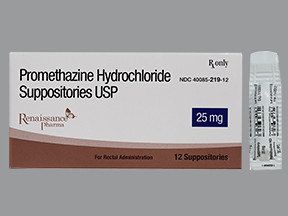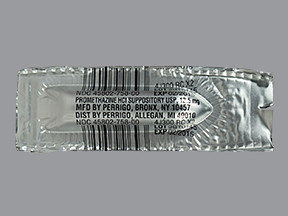PROMETHAZINE SUPPOSITORY - RECTAL
PHONETIC PRONUNCIATION: (proe-METH-a-zeen)
COMMON BRAND NAME(S): Phenergan, Promethegan
GENERIC NAME(S): promethazine HCl
Uses
USES: See also Warning section. Promethazine is used to prevent and treat nausea and vomiting related to certain conditions (such as motion sickness, or before/after surgery). It is also used to treat allergy symptoms such as rash, itching, and runny nose. It may be used to help you feel sleepy/relaxed before and after surgery or to help certain narcotic pain relievers (such as meperidine) work better. The suppository form is used when medications cannot be taken by mouth. Promethazine is an antihistamine and works by blocking a certain natural substance (histamine) that your body makes during an allergic reaction. Its other effects (such as anti-nausea, calming, pain relief) may work by affecting other natural substances (such as acetylcholine) and by acting directly on certain parts of the brain.
How to use PROMETHAZINE SUPPOSITORY - RECTAL
HOW TO USE: Unwrap and insert one suppository rectally as directed by your doctor, usually 2 to 4 times daily. Remain lying down for a few minutes after using this medication, and avoid having a bowel movement for an hour or longer so the drug will be absorbed. The suppository is for rectal use only. For motion sickness, the first dose of promethazine should be used 30 to 60 minutes before beginning travel. For allergies, this medication may be used once daily at bedtime to avoid being drowsy during the day. When used before surgery, promethazine may be used the night before or just before the procedure and may be continued afterwards as directed. The dosage is based on your age, medical condition, and response to treatment. In children, the dosage may also be based on weight. Do not increase your dose or use this medication more often than directed. Tell your doctor if your condition does not improve or if it worsens.
Side Effects
Precautions
Interactions
Overdose
Images
Reviews
Faq for PROMETHAZINE SUPPOSITORY - RECTAL
A Promethazine suppository is a medication that is inserted into the rectum and contains Promethazine, an antihistamine that is used to treat various conditions such as allergies, motion sickness, nausea, and vomiting.
Promethazine suppository works by blocking the effects of histamine, a substance in the body that causes allergic symptoms. It also acts on certain areas in the brain to help control nausea, vomiting, and motion sickness.
To use a Promethazine suppository, lie down on your left side and gently insert the suppository into the rectum using your finger. After insertion, stay lying down for a few minutes to allow the suppository to dissolve.
Common side effects of Promethazine suppository may include drowsiness, dizziness, dry mouth, blurred vision, constipation, and urinary retention. If these side effects persist or worsen, consult your doctor.
The use of Promethazine suppository during pregnancy should be discussed with a healthcare provider. It may be prescribed if the benefits outweigh the potential risks. However, it is important to consult a doctor before using any medication during pregnancy.
Promethazine suppository may be used in children, but the dosage and safety should be determined by a healthcare professional. It is essential to follow the doctor's instructions and guidelines when giving any medication to children.
Promethazine suppository can cause drowsiness and impair your ability to drive or operate machinery. It is recommended to avoid such activities until you know how this medication affects you.
Drinking alcohol while using Promethazine suppository can increase the risk of drowsiness and other side effects. It is advisable to avoid alcohol consumption while taking this medication.
Promethazine suppository may interact with other medications, including sedatives, tranquilizers, seizure medications, certain antidepressants, and anticholinergic drugs. It is crucial to inform your doctor about all the medications you are taking to avoid potential interactions.
Warning
WARNING: Promethazine should not be used in children younger than 2 years because it may cause serious (possibly fatal) slow/shallow breathing. When using this medication in children 2 years and older, the lowest effective dosage should be used, and other drugs that affect breathing should be avoided. Get medical help right away if slow/shallow breathing occurs. In children, drugs for nausea should only be used in cases of prolonged vomiting of a known cause. Avoid use of promethazine in children with liver disease (including possible Reye's syndrome).
Disclaimer
IMPORTANT: HOW TO USE THIS INFORMATION: This is a summary and does NOT have all possible information about this product. This information does not assure that this product is safe, effective, or appropriate for you. This information is not individual medical advice and does not substitute for the advice of your health care professional. Always ask your health care professional for complete information about this product and your specific health needs.




No Reviews Yet